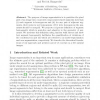Free Online Productivity Tools
i2Speak
i2Symbol
i2OCR
iTex2Img
iWeb2Print
iWeb2Shot
i2Type
iPdf2Split
iPdf2Merge
i2Bopomofo
i2Arabic
i2Style
i2Image
i2PDF
iLatex2Rtf
Sci2ools
DAGM
2009
Springer
2009
Springer
Quantitative Assessment of Image Segmentation Quality by Random Walk Relaxation Times
The purpose of image segmentation is to partition the pixel grid of an image into connected components termed segments such that (i) each segment is homogenous and (ii) for any pair of adjacent segments, their union is not homogenous. (If it were homogenous the segments should be merged). We propose a rigorous definition of segment homogeneity which is scale-free and adaptive to the geometry of segments. We motivate this definition using random walk theory and show how segment homogeneity facilitates the quantification of violations of the conditions (i) and (ii) which are referred to as under-segmentation and over-segmentation, respectively. We describe the theoretical foundations of our approach and present a proof of concept on a few natural images.
Adjacent Segments | Components Termed Segments | DAGM 2009 | Image Processing | Segment Homogeneity |
| Added | 26 May 2010 |
| Updated | 26 May 2010 |
| Type | Conference |
| Year | 2009 |
| Where | DAGM |
| Authors | Björn Andres, Ullrich Köthe, Andreea Bonea, Boaz Nadler, Fred A. Hamprecht |
Comments (0)

